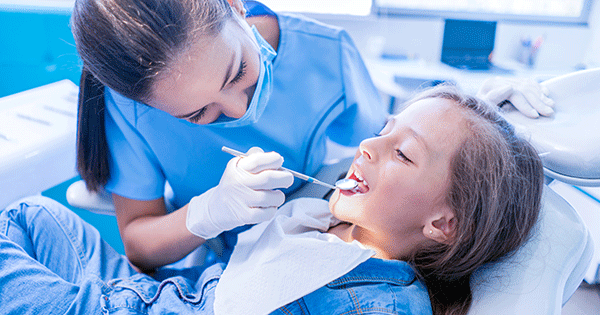
While it’s easy to say there’s no better time than February — National Children’s Dental Health Month — to talk about oral health, the truth is: we should be talking this critical issue year-round. Did you know that children ages five to 17 miss nearly two million school days annually due to dental problems? And did you know that if dental decay goes undetected, it could ultimately form an abscess and lead to flu-like symptoms? So, what can schools do to help?
We talked to Jody Callaghan, DMD, dentist at the 3toPhD® Kaiser Permanente Wellness Center at Faubion School (where our College of Education shares space with a public PreK-8 school, and several health services including a dental office). Take a look.
Can you talk about the significance of good oral health for students? And how serious is this matter?
According to the National Institute of Health, 20-30 percent of children and adolescents in the U.S. have chronic health conditions. Dental decay is the most common, occurring five to eight times more frequently than asthma, which is the second most common condition. Children with poor oral health are more likely to experience dental pain and missed school days, which in turn can absolutely affect how they perform in school.
A recent study in California found that only 17 percent of children chronically absent in both kindergarten and first grade were proficient readers by the end of third grade, as compared to 64 percent of their peers who attended regularly. If children aren’t in school, they don’t learn. Improving school attendance improves success in school.
And think about it: it is hard to eat a healthy diet with broken and painful teeth. So many of these kids end up eating a soft sugary diet which can lead to even more dental decay. Not to mention, broken, discolored front teeth can affect a child’s self-confidence. Having a healthy smile is important at any age.
So what exactly causes children to miss school days — the dental pain? Anything else?
If dental decay goes untreated, the decay will continue to get larger and closer to the dental pulp. Once decay reaches the pulp, it can form an abscess. This can cause pain and swelling, and kids can have trouble eating, Even water, too warm or too cold, can cause more pain. A dental abscess is serious and can cause children to have flu-like symptoms. Many times we need to treat it with antibiotics and pain medications.
What should schools and teachers know about oral health for children?
Early detection is important. All children should see a dentist by their first birthday. The American Dental Association actually advises parents to make dental exams a regular part of their back-to-school routine, along with sports physicals, health exams, and immunizations. Dental exams, cleaning, and early detection can all reduce dental decay. Also, healthy snacks and limited sugary drinks and soda can lead to healthier teeth and overall better health. Of course, dentists can also advise on effective preventive measures such as sealants, fluorides, and the proper way to brush and floss. Wearing a mouth guard for sports and activities can help prevent trauma and injury to the teeth.
Is there anything educators can do to help — that doesn’t cause them to go beyond their typical teaching duties?
In addition to incorporating lesson plans that feature oral health, schools could certainly try reaching out to a local dentist’s office and inviting them to come in as guest speakers. They may even bring brushes and floss with them to hand out to the kids.
And really, observation is key. Teachers can be our first line of defense in detecting early dental problems. Many of the teachers at Faubion are familiar with most of the kids and their families. They can tell when a child is having trouble eating their lunch because of painful teeth. We had a teacher call a family and recommend they come to the 3toPhD® Wellness Clinic to have their five-year-old son’s teeth evaluated. I’m so glad we were able to get this young boy treatment so he could get his dental needs taken care of before they got even worse.
We have seen several patients who had missed school because of dental pain. But we were able to get them in for dental treatment and eliminate their dental problems. Best of all, these kids were out of pain. It is so hard to concentrate in school if you are in pain.
Categorized as: Tips for Teachers and Classroom Resources
Tagged as: 3toPhD®, Physical Education and Health
